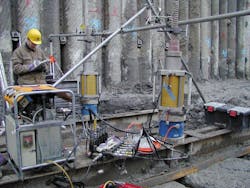Founded in 1919, Lingk + Sturzebecher, Stuhr, Germany, has decades of experience in hydraulic engineering. L+S combined this with its familiarity in carbon-fiber reinforced plastics (CFRP) to produce a line of ultra- lightweight hollow-piston hydraulic cylinders. These cylinders, with barrels constructed of CFRP, are often less than half the weight of similar standard-piston steel cylinders, and are have been used in a variety of extreme applications, from the aerospace industry in Europe to a mining operation in South Africa.
With a working pressure of 10,150 psi, the L+S cylinders are appreciably more compact and in many cases weigh only 35% as much as their steel counterparts. This enormous weight saving is achieved through the use of materials with high specific strength and rigidity, combined with modern design, analysis, and manufacturing procedures.
An example of the benefits of lightweight cylinders in the mining industry was apparent when L+S applied this technology to a bucket-wheel excavator. They replaced a steel cylinder weighing 220 lb with a CFRP cylinder of half that weight; the excavator saw an efficiency increase of 20%, when matched with an appropriately sized bucket.
Another application for CFRP cylinders is in foundation engineering. One common example has a stroke of approximately 7.8 in., a maximum working pressure of 8700 psi, and produces an axial force of approximately 112 tons. Made from conventional materials, such a cylinder would weigh 143 to 198 lb. This weight makes fitting the cylinder a heavy job for the assembly team, especially in difficult-to-reach positions. Lifting gear is usually required, along with several people.
The low weight of these cylinders makes the use of lifting gear for transporting or fitting these cylinders on site unnecessary, and the physical strain on the assembly team is drastically reduced. Tensioning tasks can be carried out in less time by a single person.
Another significant benefit is that their modular construction allows for tailor-made designs to match specific customer requirements. Thrust, stroke, and passage (the inner diameter of the hollow cylinder rod), and hydraulic and mechanical connections can be simply and quickly modified, giving a cylinder that is optimized in weight and design to the customer's needs.
Engineers at L+S are presently developing hollow-piston cylinders compatible with fresh water as the hydraulic fluid. This will eliminate the danger of ground or water contamination caused by broken hoses or leaks in threaded joints.
Lingk & Sturzebecher is now part of Parker Hannifin's Hydraulics Group. For additional information on Parker's carbon fiber reinforced hydraulic cylinders, visit www.parker.com/lightraulics.


